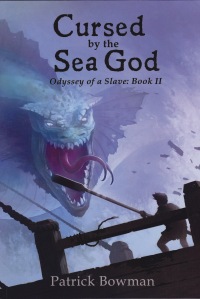This review was first published in Resource Links Magazine, “Canada’s national journal devoted to the review and evaluation of Canadian English and French resources for children and young adults.” It appears in volume 18.4.
Cursed by the Sea God
 I have been waiting for the next installment of Patrick Bowman’s Odyssey of a Slave ever since I finished the first book, Torn from Troy (2011). Cursed by a Sea God did not in any way disappoint. Torn from Troy is a retelling of Book 9 of Homer’s Odyssey, in which Odysseus begins to recount the ten years since his departure from Troy after its conquest: he tells of their encounters with the Cicones, the Lotus-eaters, and the Cyclops. In Cursed by the Sea God, the Trojan protagonist, Alexias, commonly known as Alexi, continues his journey as a slave on Odysseus’s boat, the Pelagios. After their dramatic escape from the Cyclops at the end of Torn from Troy, the Greek soldiers and sailors, and their Trojan slaves, find themselves in a land where the king has harnessed the winds—he thinks… but the winds have become powerful, and his erstwhile reasonable punishments have been resulting in his peoples’ deaths. Alexi’s outspoken nature again serves him well; with his help, Odysseus reveals the truth to the King, who grants them the powers of the wind to sail to their home in Ithaca. Bowman’s subtle humour comes into play, when King Aeolus insists that instead of “Your Majesty,” they call him “Your Inclemency.” When the sailors inadvertently release the winds, Alexi is blamed, and it takes all his wit and verbal abilities—as well as most of the novel—to regain Odysseus’s trust.
I have been waiting for the next installment of Patrick Bowman’s Odyssey of a Slave ever since I finished the first book, Torn from Troy (2011). Cursed by a Sea God did not in any way disappoint. Torn from Troy is a retelling of Book 9 of Homer’s Odyssey, in which Odysseus begins to recount the ten years since his departure from Troy after its conquest: he tells of their encounters with the Cicones, the Lotus-eaters, and the Cyclops. In Cursed by the Sea God, the Trojan protagonist, Alexias, commonly known as Alexi, continues his journey as a slave on Odysseus’s boat, the Pelagios. After their dramatic escape from the Cyclops at the end of Torn from Troy, the Greek soldiers and sailors, and their Trojan slaves, find themselves in a land where the king has harnessed the winds—he thinks… but the winds have become powerful, and his erstwhile reasonable punishments have been resulting in his peoples’ deaths. Alexi’s outspoken nature again serves him well; with his help, Odysseus reveals the truth to the King, who grants them the powers of the wind to sail to their home in Ithaca. Bowman’s subtle humour comes into play, when King Aeolus insists that instead of “Your Majesty,” they call him “Your Inclemency.” When the sailors inadvertently release the winds, Alexi is blamed, and it takes all his wit and verbal abilities—as well as most of the novel—to regain Odysseus’s trust.
The story from Homer that readers will most likely recognize is that of Circe, who turns the crew into pigs. Alexi, a pig himself, has not part in this rescue, but learns from Odysseus’s behaviour that all is not black and white. While Circe is a wicked enchantress, she is also the source of information that helps Odysseus and his crew to survive on their journey, which includes a decent into—and return from—Hades. Through it all, we are shown the complex mixture of compassion and ruthlessness that Alexi recognizes—and resents—in Odysseus: he knows that Odysseus treats him well, but knows also that he is still a slave, and a pawn in Odysseus’s clever manipulations of his crew. We are shown the depths of Alexi’s internal turmoil, and care greatly for his success and happiness. Once again, Bowman has created for young readers a faithful representation of Homer’s plot, presented in a narrative that is fantastical, fast-paced, and sure to captivate young readers.